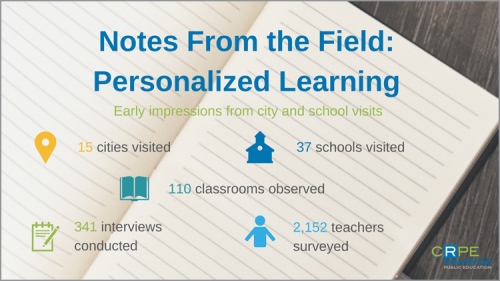Starting With the “Why” in Personalized Learning (Betheny Gross)
In 2015, The Center for Reinventing Public Education at the University of Washington Bothell, kicked off a multi-year, multi-method study of systemic efforts to support schools implementing personalized learning. We’ll produce reports that explore many of these topics in depth as the project progresses, but we want to give educators more immediate feedback. In this “Notes From the Field” series, we share noteworthy anecdotes and early impressions from our school visits, interviews, and teacher survey. These posts should be taken as observations from informed and thoughtful partners; we hope they help launch productive conversations and reflection–Betheny Gross
This post appeared April 12, 2017
Last spring, on our first visit to 35 schools committed to personalized learning, teachers often told us they weren’t sure what they were supposed to be doing to personalize learning. Revisiting the same schools this fall, we realized a more fundamental issue was at play: many teachers didn’t seem entirely sure why they were personalizing learning in the first place.
The teachers we interviewed certainly had clear goals for their students: to be ready for college and career, to be lifelong learners and successful adults. And most described the specific objectives for knowledge, skills, and attitudes their students would need to reach these goals. But only rarely could teachers tell us how the activities they do to personalize learning would deliver on these objectives. The problem is, without starting with that end in mind, it’s nearly impossible to build a coherent personalized learning (PL) approach.

In policy parlance, the teachers—and their schools—didn’t have a well-formed theory of action about PL. A theory of action explains how and why a certain intervention or approach is supposed to work. It helps get everyone on the same page about what they are doing and why. And it shapes the goals teachers and schools shoot for so they can see if their efforts are helping students achieve them. Operating without a well-articulated, well-understood theory of action leaves teachers sailing without a rudder and without a defined destination. And Starting With the “Why” in Personalized Learning (Betheny Gross) | Larry Cuban on School Reform and Classroom Practice:
